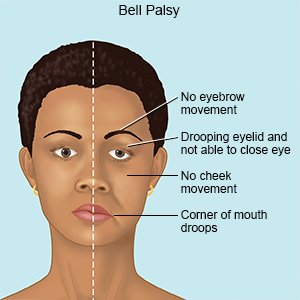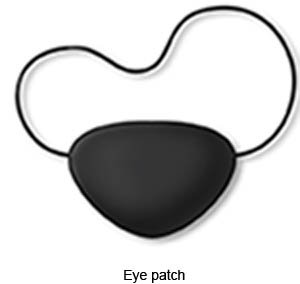Bell Palsy
Medically reviewed by Drugs.com. Last updated on Aug 4, 2025.
What is Bell palsy?
Bell palsy is a sudden weakness or paralysis of one side of your face. It occurs when the nerve that controls the muscles in your face becomes swollen or irritated. Bell palsy usually lasts about 2 to 3 weeks, but it can last for up to 6 months. Bell palsy can be permanent for some people. The cause of Bell palsy is not clear.
 |
What increases my risk for Bell palsy?
- Age 15 to 45 years
- Pregnancy or preeclampsia (high blood pressure that develops because of pregnancy)
- A virus, such as a cold, the flu, herpes simplex, or varicella (chicken pox)
- Obesity
- High blood pressure
- Stress, lack of sleep, injury, or a short illness
- A condition such as lupus, Lyme disease, Sjögren syndrome, or diabetes
What are the signs and symptoms of Bell palsy?
You may first have pain behind an ear or in your face. Hours or days later, you may have any of the following on the same side of your face:
- Weakness or paralysis in your face
- Not being able to move your eyebrow or wrinkle your forehead
- Trouble closing your eye or blinking, or your eye moves up when you try to close your eyelid
- Changes in the amount of tears and saliva you make, such as dry eyes or drooling
- Mouth drooping and trouble smiling or chewing
- Loss of taste at the front part of your tongue
- Sensitive hearing
How is Bell palsy diagnosed?
Your healthcare provider will examine you and ask about your medical history. Tell your provider about your symptoms and when they started. Your provider will test how well you can move the muscles in your face. Your provider will need to rule out other causes of paralysis, such as a stroke. Some stroke and Bell palsy symptoms are similar, but only Bell palsy prevents movement of forehead muscles. Bell palsy only affects your face. You may also need any of the following:
- An electromyography (EMG) may be used to measure the electrical activity of your muscles. An EMG also tests the nerves that control muscles.
- A CT or MRI of your brain may be done to rule out other causes of your paralysis. You may be given contrast liquid to help your brain show up better in the pictures. Tell the healthcare provider if you have ever had an allergic reaction to contrast liquid. Do not enter the MRI room with anything metal. Metal can cause serious injury. Tell the provider if you have any metal in or on your body.
Related medications
How is Bell palsy treated?
Bell palsy often goes away without treatment. Some treatments may help you get better faster or help prevent other problems caused by Bell palsy. You may need any of the following:
- Steroids may be given to decrease swelling and irritation of the nerve in your face. Your symptoms can go away faster if you get steroids 72 hours from when your paralysis started.
- Antiviral medicine may be given if your provider thinks a virus caused your Bell palsy.
- Acetaminophen decreases pain and fever. It is available without a doctor's order. Ask how much to take and how often to take it. Follow directions. Read the labels of all other medicines you are using to see if they also contain acetaminophen, or ask your doctor or pharmacist. Acetaminophen can cause liver damage if not taken correctly.
- NSAIDs , such as ibuprofen, help decrease swelling, pain, and fever. This medicine is available with or without a doctor's order. NSAIDs can cause stomach bleeding or kidney problems in certain people. If you take blood thinner medicine, always ask your healthcare provider if NSAIDs are safe for you. Always read the medicine label and follow directions.
Treatment options
The following list of medications are related to or used in the treatment of this condition.
What else can I do to help manage Bell palsy?
- Eye care may be needed to prevent vision changes, eye damage, and infection. Use eye drops during the day and an ointment at night, as directed. You may need to wear an eye patch during the day. Wear sunglasses to protect your eye from direct sunlight. Stay away from places that have particles in the air that may harm your eye. You may also need to tape your eye shut while you sleep. Get your eye checked as directed if your symptoms last longer than 3 weeks.

- Eat soft foods that are easy to chew and swallow. These foods may be chopped, ground, mashed, pureed, and moist. Do not eat hard or chewy foods. These foods may fall out of your mouth where it droops. Ask your healthcare provider or dietitian about the foods you should eat.
- Go to speech therapy if you have trouble eating or drinking that continues longer than 3 weeks. A speech therapist can teach you new ways to eat and drink. The therapist can show you ways to prevent or manage problems with drooling or swallowing. You may also learn to plan several small meals instead of a few large meals each day.
- Use ear plugs or ear protectors around loud noises, such as a lawnmower or loud music. Foam earplugs that completely block your ear canal can help decrease your sensitive hearing. Do not listen to loud music through headphones or earphones.
- Go to physical therapy as directed. A physical therapist can teach you how to massage and exercise the muscles in your face. These exercises may help prevent long-term problems such as muscle spasms and permanent paralysis in your face.
- Talk to a mental health therapist if your symptoms are causing a low mood or anxiety. The therapist can help you cope while you recover.
When should I seek immediate care?
- You have vision changes or a loss of vision.
When should I call my doctor?
- You have a fever.
- Your eye becomes red, irritated, or painful.
- Your symptoms have not gone away after 3 weeks.
- You have questions or concerns about your condition or care.
Care Agreement
You have the right to help plan your care. Learn about your health condition and how it may be treated. Discuss treatment options with your healthcare providers to decide what care you want to receive. You always have the right to refuse treatment. The above information is an educational aid only. It is not intended as medical advice for individual conditions or treatments. Talk to your doctor, nurse or pharmacist before following any medical regimen to see if it is safe and effective for you.© Copyright Merative 2025 Information is for End User's use only and may not be sold, redistributed or otherwise used for commercial purposes.
Further information
Always consult your healthcare provider to ensure the information displayed on this page applies to your personal circumstances.
